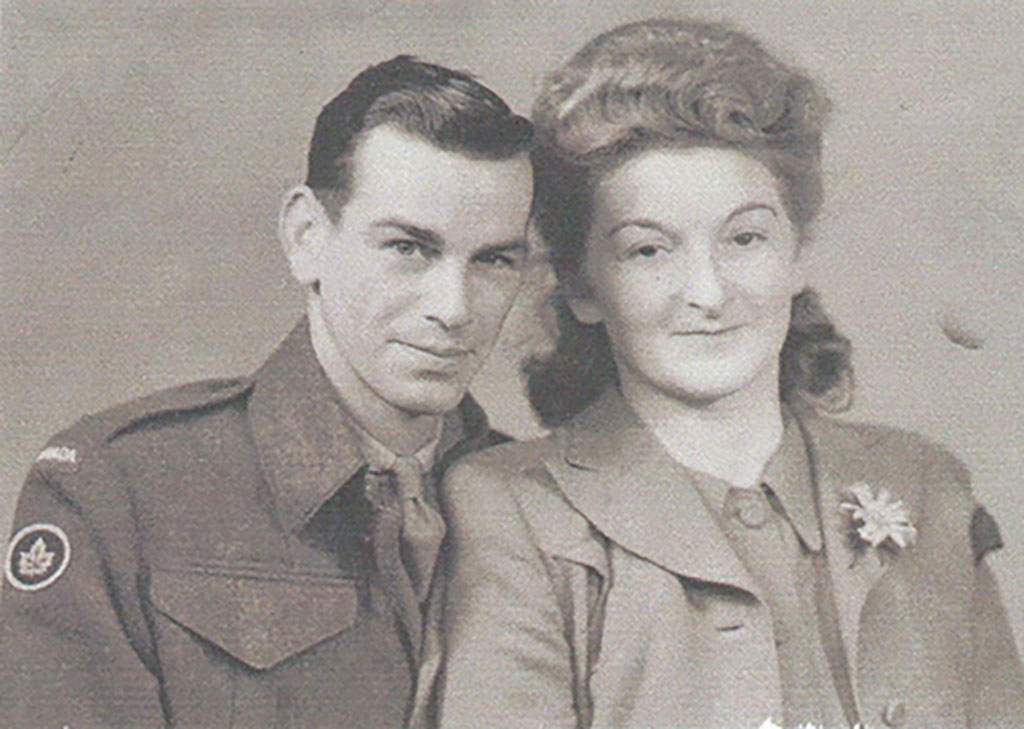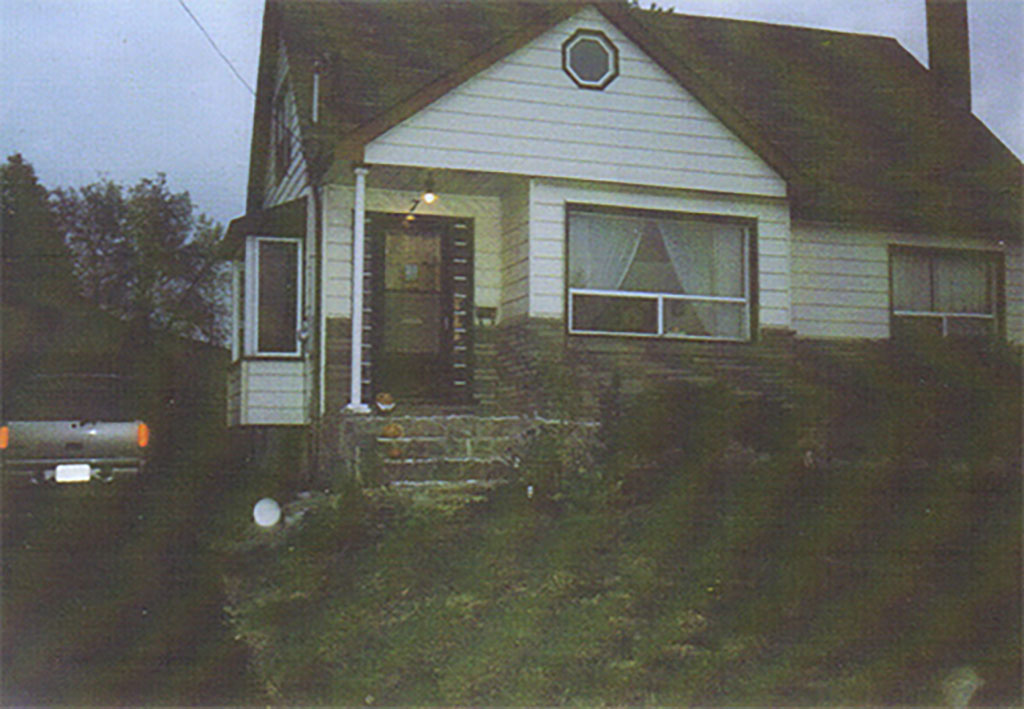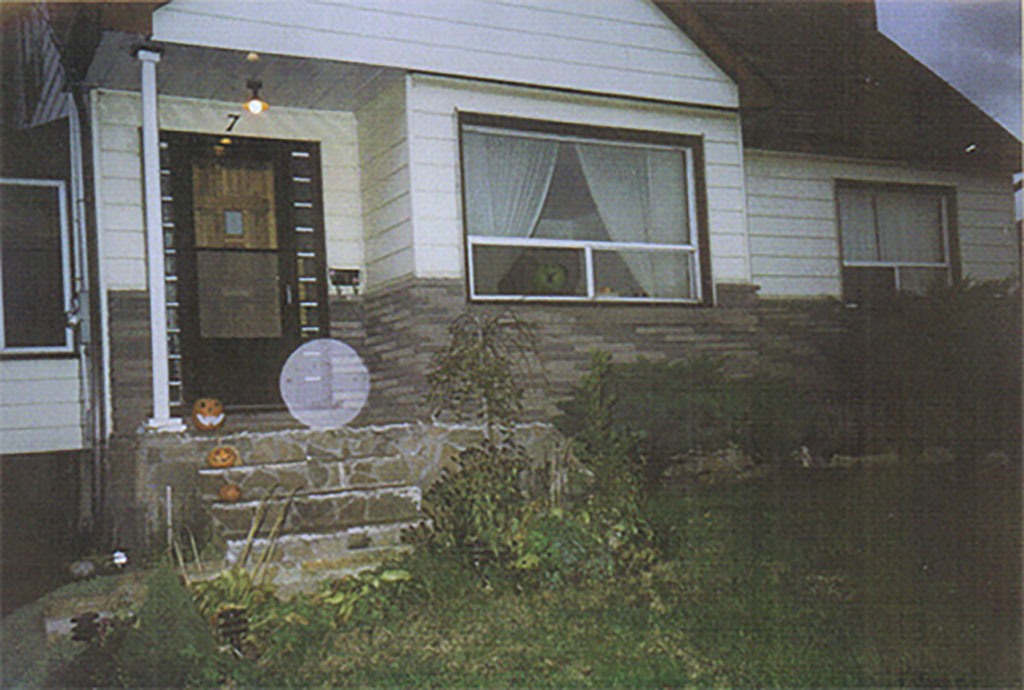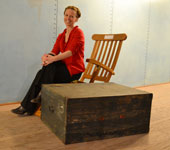
Joanne Collicott Mc Guigan was born to Canadian serviceman Ralph Benjamin Collicott and his war bride Kay on a Halloween night. The moon was full as bombs fell around the Hammersmith hospital demolishing half a block across the street. After the war her father returned to Canada while she and her mother went back to Kay’s hometown of Kiltane, Co. Mayo in the Republic of Ireland to await word of their crossing to Canada. Joanne writes, “Once my father had left for Canada, Mother quickly fell back into the life she had before going to England. She rode her bike, with me seated in a carrier behind her, around the breathtaking Irish countryside. As we visited friends and relatives, away from the horrors of the war, Mother said it felt good to be home in Kiltane. It really was a magical land, this Ireland, where the clouds reached down and touched the hills of Mayo. As a child Mother has believed that the little people lived in those hills. If you ever caught one, your every wish would come true.”
Kay was reluctant to leave her family and beloved Ireland but she was brave and took Joanne on the last war bride crossing organized by the Canadian military. Here Joanne recalls her childhood in Canterbury, New Brunswick. “I remember many evenings when she would teach my cousin Bobby and I to do a dance called the fox-trot. Other times she would teach us the old fashion waltz. Mother laughed a lot and liked to play pranks on us. She liked to play cards and to play for money! I remember playing a game called 45’s for a quarter a game. Mother learned to knit from Nanny and then she taught a lot of the other women from the community who would come for an afternoon visit. In 1960, I remember a beautiful sweater with skaters on the front she had knit for me. Of course I wasn’t the only one. All winter long she would be knitting something for one person or another. Mother was not a reader but she loved watching her favourite hockey team, The Toronto Maple Leafs, on the small black &white television we acquired in early 1960.”
Another memorable woman in young Joanne’s life was her paternal grandmother. She recalls, “Nanny had lived about ½ mile from our home. Her bachelor son, Sam, and her grandson, Bobby, lived with her. Nanny’s funeral is still very vivid in my mind. At the Primitive Baptist church in Canterbury, Nanny’s casket was open and after the service everyone trooped up by the casket to view her lifeless body. I was eleven at the time and I could not believe that I had lost Nanny forever. My father was never the same after Nanny died. It seemed he was never again the happy fun loving father of my childhood. Nanny had been the matriarch of the Collicott family and she had kept her sons in line, probably without even knowing it.
Nanny had died at her daughter, Pauline’s, in Houlton, Maine, on February 10, 1956. Everyone in the family had a forerunner of her death. Father was away working at a lumber camp and he said there were 3 knocks to the door that night. He went to the door but no one was there. It was February and fresh snow had fallen but there were no footsteps in the snow. Twice more the three knocks came but no one was there. Father knew that his mother had died. That same night mother and I were asleep in separate bedrooms at the home in Canterbury when we both woke to the sound of an owl screeching. The owl seemed to be at the bedroom window where mother was sleeping. Within a few minutes the phone rang and it was Pauline telling us that Nanny had died. At this time, besides me, mother had two boys, Shaun, 5 years old and Kevin, just six months. Mother left me with the boys, who were sleeping, and she ran down towards Nanny’s house to tell Uncle Sam that Nanny had died as he did not have a phone. Mother meets Uncle Sam coming towards her on the road.
'I know', he said but he would never tell anyone for years that Nanny had appeared to him that night.”
Kay Collicott died on Joanne’s birthday in 1987. She was 67 years old. She had been married 44 years and given life to five children. Since coming to Canada she had gone through two major heart surgeries and experienced the heartbreaking loss of a child. Joanne writes that she never lost her lilting Irish accent and would get upset when people couldn’t understand what she was saying. She never got used to our cold winters and dearly missed her family back in Ireland but through it all she was glad to have come to Canada and she thought it was a great opportunity for her children. Joanne concludes her story with two photographs and these words, “On Nov 1, 2002, while my father was staying with me in Whitby, Ontario, I took these pictures of the Halloween pumpkins at the front of my house. If you look closely to the left under the protruding window you will see a small white globe. Then in the next picture you will see that the globe (or spirit orb) has enlarged and moved to the top step. Also the solar light that was beside the small white globe (or orb) came back on once the orb enlarged and appeared on the top step. The same thing happened with the solar light on the ground in front of the enlarged orb. It would appear that the spirit used the energy in the solar lights to make itself known.


Spirit orbs have been known as one way that angels have appeared. It has been said the larger ones are soul gatherers and may help to guide us home once we have left the physical body.
I like to think after fifteen years, Kay of Kiltane was waiting to bring her Canadian soldier safely home.
Father died at age 86 on December 21, 2002 (less than 2 months after these pictures were taken).”
